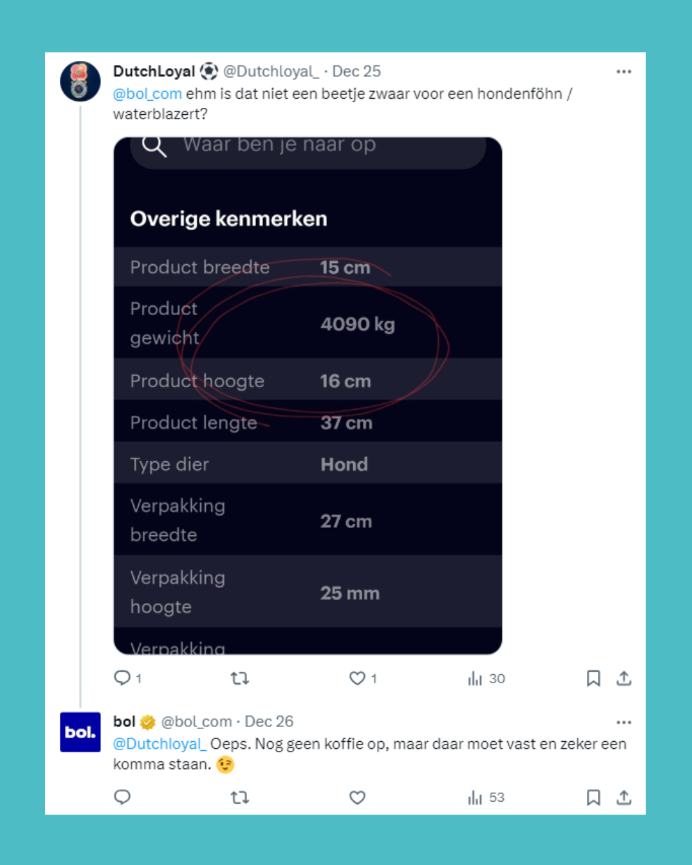A standard response such as “Dear customer, thank you for your message. It is best that you contact us via email.” is certainly no longer the way to go. And that’s why conversation management is oh so important. It’s the part of social media marketing in which you as a brand interact with your current and potential customers. From comments under your posts to communication through messaging apps. So time to take your conversations to the next level!
Make it personal
Rule number one: don’t come across as a robot or a computer answering questions. A research of Sprout Social shows that 70% of consumers expect a company to respond personally when they call on customer service.
For example, you can use their first name so that people feel more addressed. A nice personal touch really makes a difference. ‘Cause people want to communicate with people, not machines after all.
Tip: Throughout your conversations, does someone provide additional information, such as their birthday? Use this and do something special with it. You can send a nice birthday message, or even send a small gift. This falls under the surprise & delight technique. 🥳
Be consistent and clear
Think carefully about how you want to communicate, or what tone of voice you adopt. For example, don’t be very formal one time and very informal the next time. Make it easy for yourself and your team and use a document in which you list all the rules. This way, you can quickly look back for guidelines on things such as emojis, salutations or frequently asked questions.
Also, be consistent in your response. Either answer everything or don’t. It comes across a bit odd if you answer one question and others not. Good agreements, make good friends. 🤝
Managing expectations
People expect an answer quickly when they ask a question on social media. Some even very quickly. You need to take that into account in your conversation management strategy. . Researsh shows that 76% of consumers appreciate a quick response from a company.
The guideline on response time varies by type of company. Very large organizations, which often use a call center for their conversation management on social media, usually respond within the hour. Of course, this isn’t feasible for all companies and organizations. So make sure your customers have the right expectations. Literally state what they can expect when. That way, there cannot be any misunderstanding. By the way, immediate service doesn’t mean they expect an immediate solution, but they do want to be heard quickly and receive a response. 📲
Tip: On Meta, it’s possible to set up automatic replies . If you enable these, people will automatically receive a response from your company when they interact with your Facebook page or Instagram account. This way, you can greet people in advance and let them know when to expect a response. With that said, it’s important to keep your promises. If you can’t stick to a specific timing, you can also write something like “We’ll get back to you as soon as possible”.
Dealing with negative messages
Negative feedback is (unfortunately) also a part of conversation management. Such feedback can quickly go viral on social media and reach a wide audience. This is precisely why it’s even more important to deal with it properly. We give you some tips. 👇
Respond with the right tone
Does the message contain potentially unjustified and perhaps even aggressive language? Don’t get carried away by emotions and don’t be too impulsive. If you do, you may face bigger problems than just negative feedback. So stay polite and friendly. Try to respond in a civilized and calm manner. After all, a friendly tone is the basis of a good conversation. 😉
Take criticism seriously and admit mistakes
Anyone who has something to complain about wants to be taken seriously. Even if (in your eyes) the criticism is unjustified. Show interest in the customer’s opinion and make it clear that you’re listening to him, her or them. he customer’s review is publicly available on the internet. Therefore, proper handling is crucial. Show other dissatisfied customers that you care about solving the problem and respond extensively to feedback.
In addition, we often read, “what a shame to read that” without explicitly writing “sorry”, whereas that can do wonders if a mistake was effectively made. So also just take responsibility when something really went wrong. Everyone makes mistakes and a customer is open to forgiving if you’re honest about it, and apologize.
The rule of 3
Don’t send a third reply to someone who keeps responding negatively and is clearly not open to feedback. Then it quickly becomes a discussion and no longer a reply. A third reply is the time to continue the conversation offline and/or privately.
Our favorite examples
A mistake on the website? Bol.com knows the best way to respond.

Coolblue loves that their cardboard boxes get a new purpose.

Sometimes you don’t need to say many words. And Costa Coffee know that better than anyone.


